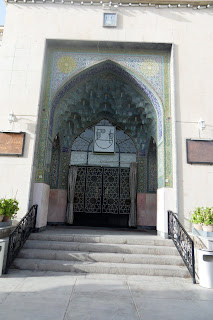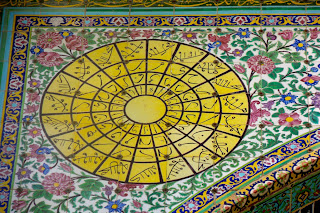



Iran is around 90% Shi'i and there are only a few Sufi orders that are active in the Shi'i world: Nematollahi (Gonabadi and Nurbakhsh branches) and the Dhahabiya/Ahmadi. In primarily Sunni Kurdistan, the Qadiri and Naqshabandi orders are prevalent.
While doing a little research on the topic of Sufism in Iran, I was surprised to discover most of the articles and websites I wanted to access were blocked by the Iranian government.
Sufi orders are suppressed in Iran, mainly for political reasons as Sufis usually support the opposition government. Sufism also poses a threat to the established orthodox order and lots of rumors are spread about the un-Islamic practices and because Sufis tend to follow their shaykh/pir instead of state-recognized mujtahids, or experts in Islamic law.
Here in Shiraz, there previously used to be a number of Sufi khanaqahs (lodge), but the government has methodically been closing them down over the years - only one has been spared - the Dhahabiya order located in old Shiraz still remains due to its specifically orthodox adherence to Shi'i Islam. I heard that the Nematollahi khanaqah was taken by the government and turned into a government office.
In Tehran, there are more khanaqahs and they are harder to keep track of in the giant metropolis, but Shiraz is a relatively small city and it has been easy to the government to systemically suppress the local Sufis. Even this very week, a professor of Persian literature at Shiraz University, Dr. Muhammad Nayari, and follower of the Dhahabiya order was specifically named in a book by an orthodox Shi'i scholar, along with the rest of his order, stating that it was against Islam and a danger to the regime. This order has already gone to great lengths to establish itself as an orthodox Shi'i order, women and men are separated in different rooms, they hold Shi'i ceremonies as well as circles of remembrance, and have designed their khanaqah to look the same as a regular Shi'i mosque/shrine. Still, it is not enough for the government, who is not fond of the politics of the order, namely their support for Mousavi, and much like the Wahabbis in Saudi Arabia, will formulate any old argument to criticize and stigmatize the Sufis.
So I happened upon this khanaqah quite by chance, I had been wandering the narrow alleys of old Shiraz, specifically around Sang-e siah (the black stone), one of the most well-known lanes that contains tombs of famous Shirazis, including Sibuyah, the Arabic grammarian (who was Persian!), beautiful historical homes, churches, synagogues, and tombs of descendants of the Prophet and Imams. Anyway, since I noticed an alley labeled as "khanaqah" on my map, I figured I might try and look for it. I had tried to ask Dr. Niyari if I could visit it, but his response was vague and I think because of his current volatile situation, he was reluctant to let me (as a foreign American, albeit Muslim woman) visit under his supervision. Nevertheless, I was determined to find the last remained Sufi khanaqah in Shiraz...
I finally came across the back door of the khanaqah, just a plain white door and graffitti on the wall, "Death to America." I lost hope that I couldn't get inside, so then started wandering around, looking for another historical house to visit. I couldn't seem to find the house (the map I have has a lot of mistakes in regards to locations of historical sites in the alleys of old Shiraz), and so finally bought some water and asked the owner of the store where I might find the house. He had no idea where it was, but while I was wasting my time with him, a woman came up, shook my hand and said "salams." And the amazing thing is that I knew her, she had been in the class I had attended at Shiraz University in Islamic philosophy, and we had spoken at some length. Not only was it an amazing coincidence to meet someone I know in a narrow alley of old Shiraz, but she had also just come from the Dhahabiya khanaqah and invited me to visit it with her. I of course agreed, thinking that this was some amazing naseeb/fate and off I went, following F. to the khanaqah.


We arrived to a grander door than the one I found (I had only found the back door), and F. ringed the bell and we were let in. Inside was a large complex of buildings, a library, prayer hall/shrine room, women's room, and some other buildings. It was quite busy and men were coming and going from the khanaqah. We went into the prayer hall prayer hall/shrine room where we were met by an indescribably sweet and attractive smell and an exceedingly clean room. The room contained two gravestones covered in glass, presumably of important Dhahabiya shaykhs/pirs, and also had a minbar/pulput. Male dervishes sat around the edges of the room, quietly reading Qur'an and doing their zikr. A woman was paying her respects to the gravestone of the shaykhs and we wandered around the room. We then went to the women's room - I have never seen such a clean and well-lit prayer room for women - where I prayed Asr and said salams to the women who were hanging out there. The library was also impressive, we had to take off our shoes to go in and put on some white plastic flip-flops, the library is said to have an extensive collection of books on Sufism as well as a decent-sized collection of manuscripts.
All in all, the khanaqah was an impressive complex,but it is a shame that the government has suppressed Sufism in the country and that there is only one khanaqah left in the city.
Tonight I am going back as it is the birthday of Imam Ali (as well as father's day in Iran) and there will be a celebration that includes lots of duas (supplications), prayers, and praises of Imam Ali.














